Chapter 2 Tissues Short Answer Type Question And Answers
Question 1. If a potted plant is covered with a glass jar, water vapours appear on the wall of glass jar. Explain why?
Answer.
If a potted plant is covered with a glass jar, water vapours appear on the wall of the glass jar
It occurs due to transpiration.
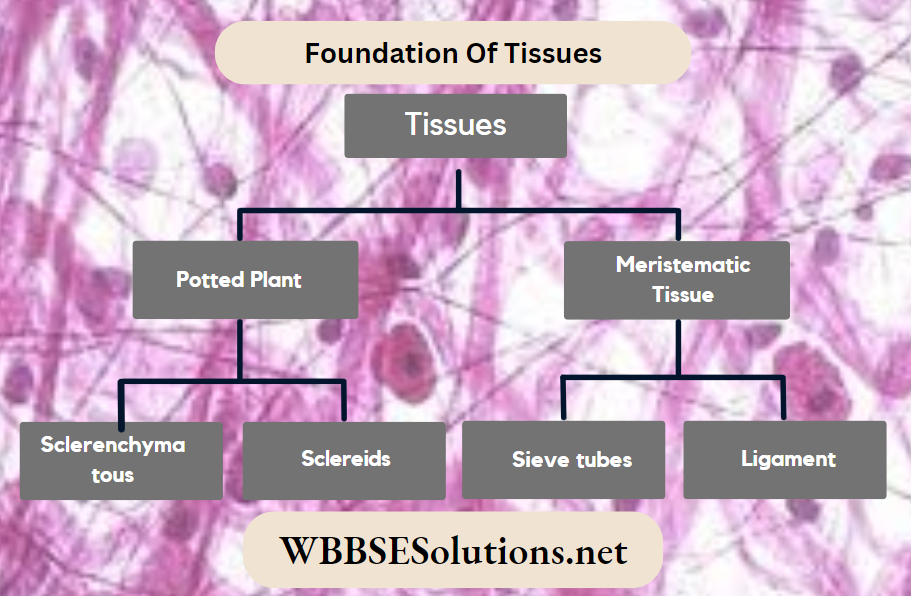
Question 2. Discuss the characteristics of meristematic tissue.
Answer.
The characteristics of meristematic tissue:
The cells are oval, rounded or polygonal in shape. The cells are living with thin cellulose walls and without any intercellular spaces The cells are rich in cytoplasm with very small vacuoles. The cells are diploid and undergoes mitosis. The cells do not contain reserve food materials, endoplasmic reticulum and plastids.
Question 3. Discuss the characteristics differences between sclerenchymatous fibres and sclereids.
Answer.
The characteristics differences between sclerenchymatous fibres and sclereids:
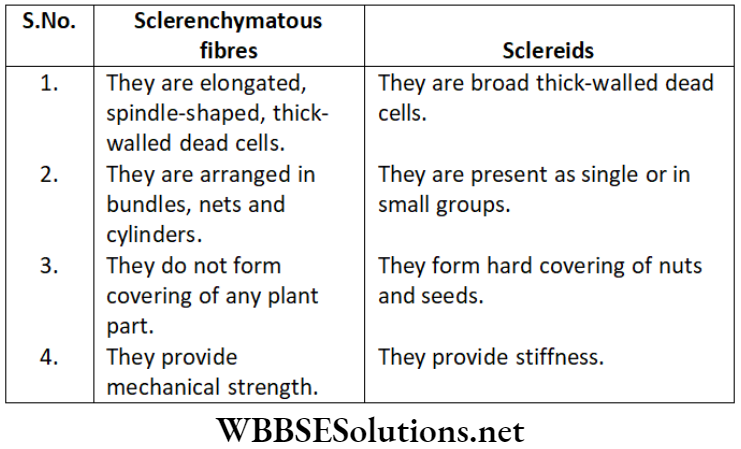
Question 4. What are sieve tubes?
Answer.
Sieve tubes:
These are slender, tube-like structures that consist of elongated thin-walled cells, placed end to end. The end walls of these cells are perforated by several pores and are known as sieve plates.
Question 5. Describe the differences between tendons and ligaments.
Answer.
The differences between tendons and ligaments:

Question 6. Discuss the differences between bone and cartilage.
Answer.
The differences between bone and cartilage:

Question 7. What are phagocytes?
Answer.
Phagocytes:
These are capable of phagocytosis and helps in the defence of body by engulfing bacteria and other foreign substances. Phagocytes are of two types, namely granulocytes and agranular leukocytes
Question 8. Discuss the differences between endocrine and exocrine glands.
Answer.
The differences between endocrine and exocrine glands:

Question 9. Describe characteristic features between unicellular and multicellular glands.
Answer.
Characteristic features between unicellular and multicellular glands:

Question 10. Discuss the differences between plant and animal tissues.
Answer:
The differences between plant and animal tissues:
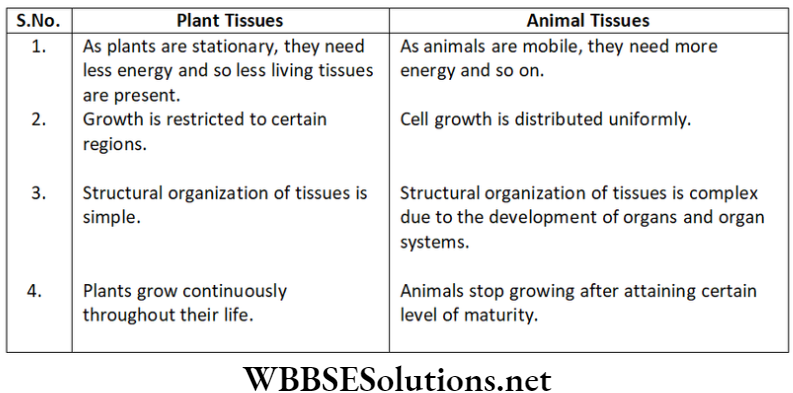
Question 11. What do you understand by the term ‘Division of labour’ in the organisms?
Answer:
‘Division of labour’ in the organisms:
Division of labor in organisms enables a smooth and efficient functioning in the body for better survival. Different functions are performed by different groups of cells in an organism, and this is called division of labour in the organisms.
Question 12. What is histology?
Answer:
Histology:
The study of tissues is known as histology.
Question 13. What do you understand by tissue?
Answer:
Tissue:
Tissue is a group of cells that are similar in structure and organized together to perform a specific function.
Question 14. Where is apical meristem found?
Answer:
Apical Meristem:
Apical meristem is present at the growing tips of stems and roots. Their main function is to initiate growth in new cells of seedlings, at the tip of roots and shoots.
Question 15. Discuss the characteristics of plant tissues.
Answer:
The characteristics of plant tissues:
- Plant tissues provide mechanical strength to the internal as well as external organs.
- Provide elasticity and flexibility to the plant organs.
- Plant tissues help in the transportation of materials across the plant body and prevents loss of water.
- They undergo division to help the plants to grow both in length and girth.
- The plant tissues are involved in many metabolic processes, such as photosynthesis, respiration, etc.
Question 16. What are meristematic tissues?
Answer:
Meristematic Tissues:
Meristematic tissue is a group of dividing cells that has the capacity to divide and re-divide and help in the growth of plants.
Question 17. What do you understand by the term histogen?
Answer:
Histogen:
Dermatogen produces epidermis, where periblem gives rise to cortex and endodermis and plerome to vascular bundle and pith. These three layers were termed as histogen.
Question 18. Discuss different types of meristematic tissues.
Answer:
Different types of meristematic tissues:
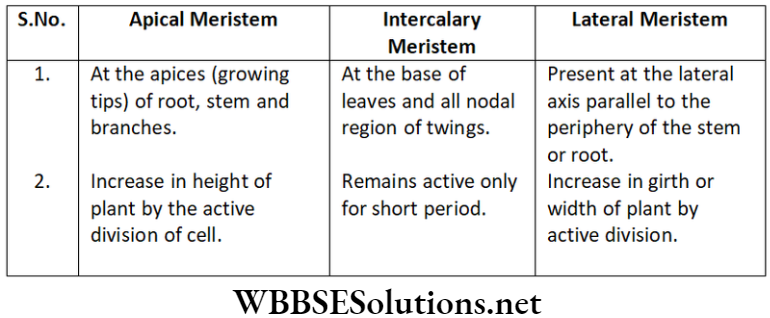
Question 19. Discuss the characteristics features between meristematic and permanent tissue.
Answer:
The characteristics features between meristematic and permanent tissue:
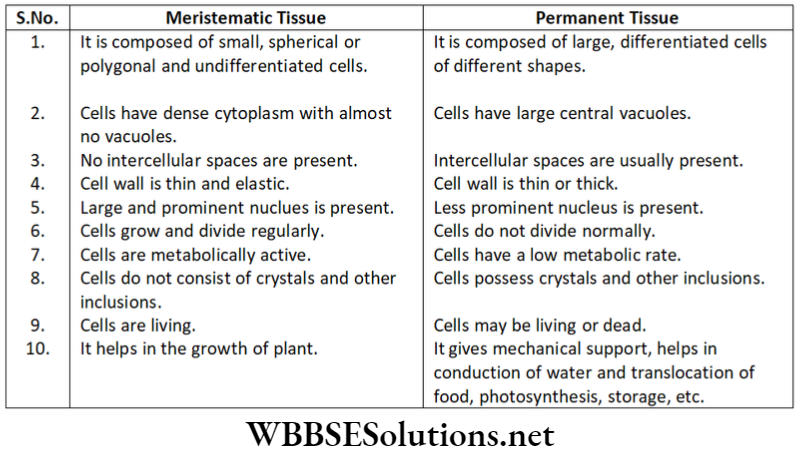
Question 20. How are simple tissues different from complex tissues in plants?
Answer:
Simple tissues are made up of one type of cells which coordinate to perform a common function. Complex tissues are made up of more than one type of cells. All these coordinate to perform a common function.
Question 21. How many types of elements together make up the xylem tissue? Name them.
Answer:
Xylem is a complex tissue. It is made up of the following four kinds of cells or elements.
- Tracheids
- Vessels
- Xylem parenchyma
- Xylem fibres
Question 22. Which tissue makes up the husk of coconut?
Answer:
The husk of a coconut is made up of sclerenchyma tissue.
Question 23. What are the constituents of phloem?
Answer:
Constituents Of Phloem:
Phloem is the food conducting tissue in plants. It is made up of four components as listed below.
- Sieve tubes
- Companion cells
- Phloem parenchyma
- Phloem fibres
Question 24. Discuss the differences between parenchyma, collenchyma and sclerenchyma.
Answer:
The differences between parenchyma, collenchyma and sclerenchyma:

Question 25. Discuss the characteristics features between xylem and phloem.
Answer:
The characteristics features between xylem and phloem:

Question 26. What do you understand by stomata?
Answer:
Stomata:
Stomata are the pores found in the epidermis of leaves, stems and other organs, which are used to monitor gaseous exchange.

